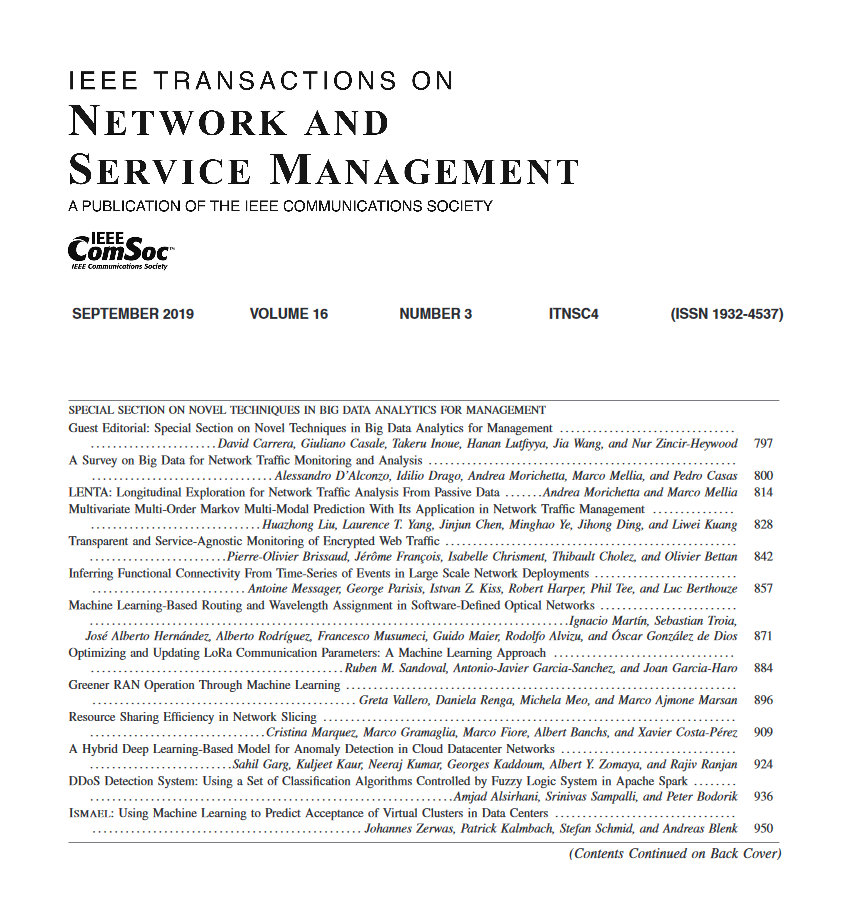Energy-Efficient Node Localization in Time-Varying UAV-RIS-Assisted and Cluster-Based IoT Networks
IF 5.4
2区 计算机科学
Q1 COMPUTER SCIENCE, INFORMATION SYSTEMS
IEEE Transactions on Network and Service Management
Pub Date : 2025-04-16
DOI:10.1109/TNSM.2025.3561269
引用次数: 0
Abstract
This paper proposes a novel method for energy-efficient node localization in time-varying Internet of Things (IoT) networks. The method utilizes Unmanned Aerial Vehicles (UAVs) and Reconfigurable Intelligent Surfaces (RISs) over cluster-based IoT networks, resulting in improved localization accuracy and Signal-to-Interference plus Noise Ratio (SINR) at the Base Station (BS). First, the proposed method computes the approximate coordinates of the User Equipments (UEs) through trilateration, utilizing a dataset comprising the coordinates of anchor nodes and Received Signal Strength (RSS) between UE-RIS pairs. Subsequently, K-means clustering is applied to efficiently group UEs based on their spatial proximity, leading to optimal RIS requirements. To further enhance the localization precision of the UEs, a Reinforcement Learning (RL) algorithm with a collision avoidance mechanism is employed over UAVs mounted with RIS. This innovative approach dynamically relocates a UAV-RIS pair to a maximum SINR position over the cluster. To compute the SINR value over a spatial location in the network, a novel approach is proposed herein, which utilizes a radio map of the network. Subsequently, the relocation of the UAV-RIS pair is followed by a novel method for computing the optimal phases of RIS elements, maximizing SINR at the BS. The final step involves Capon beamforming, strategically applied to antenna elements at the BS, resulting in further SINR improvement at the BS. The holistic integration of trilateration, clustering, RL, and beamforming collectively contributes to a system that achieves energy-efficiency, accurate localization, and enhanced SINR at BS. Experimental results demonstrate the effectiveness of the proposed methods, showcasing their potential for application in real-world scenarios where energy consumption and localization accuracy are critical considerations. To validate the significance of the proposed methods’ utilization, the proposed methods’ performance is also compared with that of existing methods.时变无人机- ris辅助和基于集群的物联网网络节能节点定位
提出了一种时变物联网(IoT)网络中节能节点定位的新方法。该方法在基于集群的物联网网络上利用无人机(uav)和可重构智能表面(RISs),从而提高了基站(BS)的定位精度和信噪比(SINR)。首先,该方法利用包含锚节点坐标和UE-RIS对之间接收信号强度(RSS)的数据集,通过三边测量计算用户设备(ue)的近似坐标。随后,应用K-means聚类,根据ue的空间接近度对其进行有效分组,从而获得最优的RIS需求。为了进一步提高ue的定位精度,在安装了RIS的无人机上采用了一种带有避碰机制的强化学习(RL)算法。这种创新的方法动态地将无人机- ris对重新定位到集群上的最大SINR位置。为了计算网络中空间位置上的SINR值,本文提出了一种新的方法,该方法利用网络的无线电地图。随后,在UAV-RIS对的重新定位之后,采用了一种新的方法来计算RIS元素的最优相位,从而最大化BS处的SINR。最后一步涉及Capon波束成形,策略性地应用于BS的天线元件,从而进一步提高BS的SINR。三边测量、聚类、RL和波束形成的整体集成共同促成了一个系统,实现了能源效率、精确定位和增强的SINR。实验结果证明了所提出方法的有效性,展示了它们在能源消耗和定位精度是关键考虑因素的现实场景中的应用潜力。为了验证所提方法应用的意义,还将所提方法的性能与现有方法进行了比较。
本文章由计算机程序翻译,如有差异,请以英文原文为准。
求助全文
约1分钟内获得全文
求助全文
来源期刊

IEEE Transactions on Network and Service Management
Computer Science-Computer Networks and Communications
CiteScore
9.30
自引率
15.10%
发文量
325
期刊介绍:
IEEE Transactions on Network and Service Management will publish (online only) peerreviewed archival quality papers that advance the state-of-the-art and practical applications of network and service management. Theoretical research contributions (presenting new concepts and techniques) and applied contributions (reporting on experiences and experiments with actual systems) will be encouraged. These transactions will focus on the key technical issues related to: Management Models, Architectures and Frameworks; Service Provisioning, Reliability and Quality Assurance; Management Functions; Enabling Technologies; Information and Communication Models; Policies; Applications and Case Studies; Emerging Technologies and Standards.
 求助内容:
求助内容: 应助结果提醒方式:
应助结果提醒方式:


